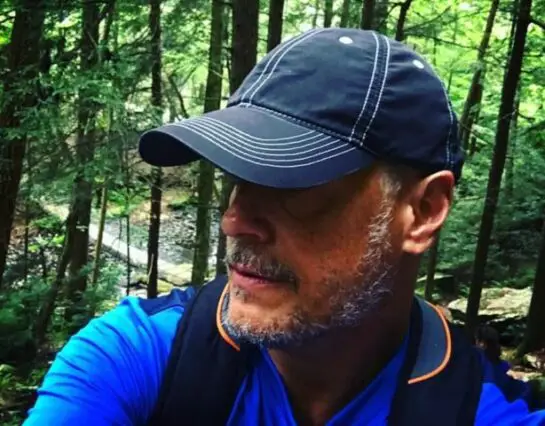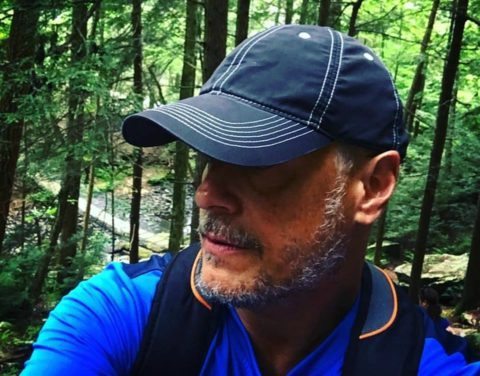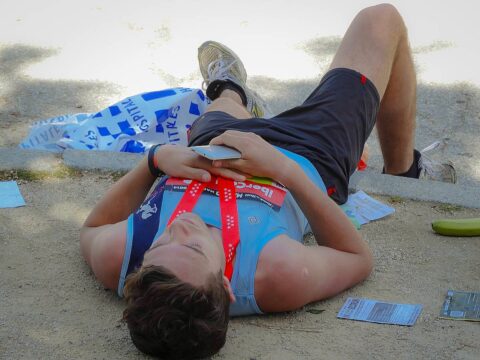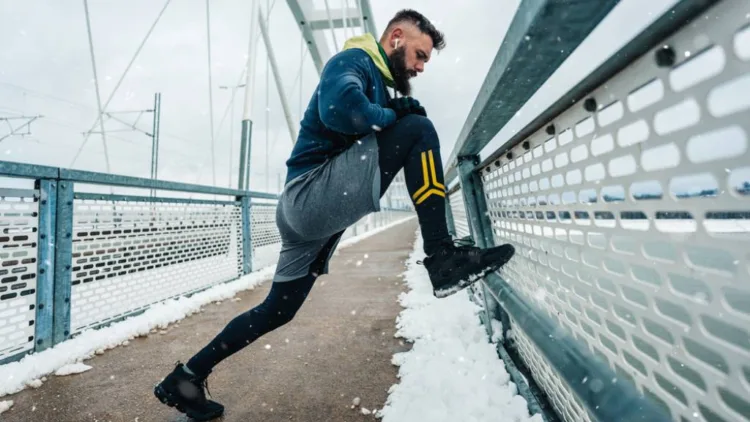I ran 100 miles in the Holston River Endurance Challenge.
The experience was a lot of things and mostly not what I expected it to be.
To be fair, I had unrealistic expectations mostly because I ripped off an 85-mile run a few weeks prior on a washed-out/mud-caked trail at the Ozone Endurance Challenge. So, doing a 100-mile flat-trail run on a sunny day in August didn’t seem like a very difficult thing to do.
It was. This 100-mile race was difficult.
It Was Exhausting From The Start
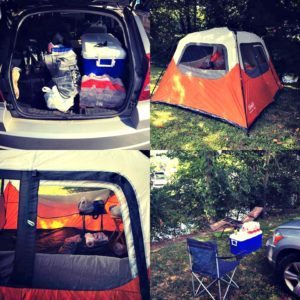 I’ve never started a race in the nighttime hours but the Holston River run started at 8 p.m.
I’ve never started a race in the nighttime hours but the Holston River run started at 8 p.m.
I was up early that morning, traveled almost 5 hours to get to the race, and then had my staging area to set up — which included setting up a tent and sorting out lots of other gear.
Standing on the starting line at 8 p.m., I had already put in a full day of traveling and activity. I didn’t do all the set-up on my own, but the point is that I was at the end of a full and active day before the race ever began.
It Made Me Dig Deeper
I’ve learned now to be wary of ultramarathon courses that are described as “mostly” flat. It’s what’s left after the “mostly” part that can do you in. A short steep hill on mile 10 can be a little annoying, but that same hill on mile 80 can be agonizing – the downhill too, maybe even especially the downhill.
The heat and humidity during the light hours of the run was pretty typical of a hot August day. But because the course was more exposed, you had no protection from the sun beating down on you – hour, after hour, after hour, after hour. So after running 12 hours through the night, you were rewarded by another 12 hours of running in the sun and heat of the day.
There are different strategies ultra-runners use in races of this distance. Like many runners, my plan was to run the bulk of the 100 miles and strategically employ walking for the difficult inclines.
Runners had 36 hours to complete 100 miles. Some runners chose to sleep for 30 minutes to a couple hours in their tent during the race, hoping the rest would boost their overall performance. I elected not to sleep and only took brief aid-station/refueling breaks.
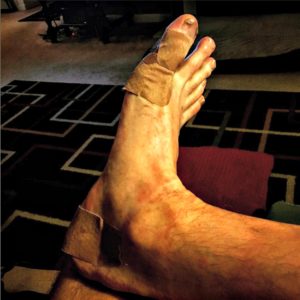 From 5 a.m. on Friday morning and through 24 hours of running starting at 8 p.m. that evening, I had not slept for 40 hours as I was nearing the end of the 100-mile race.
From 5 a.m. on Friday morning and through 24 hours of running starting at 8 p.m. that evening, I had not slept for 40 hours as I was nearing the end of the 100-mile race.
I had painful feet blisters, chaffing of my arms and legs, sunburn on my nose, and aching legs. It wasn’t exactly a pretty picture for Instagram and some caption about “runners high.” I had been telling myself that once I got to 90 miles, I would see the end in sight and feel inspired to knock out the final 10 miles. Instead, when I got to 90 I said to myself, “Damn; I have 10 f***ing miles still to run!”
I didn’t feel especially good or at my best on this run. It’s possible I had over-trained and perhaps did not taper properly. There were moments when I wondered if I was going to be able to run the entire 100 miles… or if I even wanted to try based on how crappy I sometimes felt. But this is just the kind of mental stuff you have to find a way to work through as an ultra-runner.
Despite the physical pain and defeatist thoughts dancing around in my head, I had to dig deeper and just keep running. And I did.
It Was Indeed A Challenge
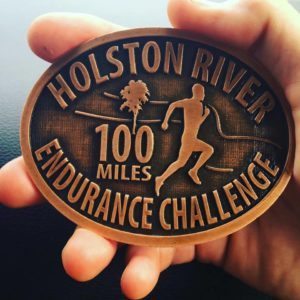 So yes, the 100-Mile Holston River Endurance Challenge was difficult.
So yes, the 100-Mile Holston River Endurance Challenge was difficult.
It was not easy. But then there’s that moment you realize it was never supposed to be. That’s why it’s called a “CHALLENGE.” It was not meant to be “easy.”
You have to earn your 100-mile buckle. They don’t fall off trees or get handed out for a jog through the park or even a marathon through one. You have to do it the old-fashioned way by earning it… one sweaty, bloody, painful mile at a time.
There were a couple mental breakdowns along the way and a few times when I was seeing things that weren’t really there – but I did it. I finished 100 miles and even a little more than that.
It Was Solitary And Communal
I ran this 100-mile race alone – meaning that I wasn’t running the trail with another person like a running partner or other runners I had arranged to run with. Though there were some familiar faces at the race, I ran most of the 100 miles by myself.
It can be helpful to run a long endurance race like Holston River with a running friend – because you can support one another through the difficult stretches and even distract each other from the long task at hand through conversation and a familiar presence at your side. But this wasn’t my scenario this time around and I ran alone.
I enjoyed running the dark hours this way. There was nature’s chorus of nighttime sounds and stretches of quietude and tranquility that were serene. In those moments I felt deeply alive – connected to all and peaceful within myself. But running the daytime hours by myself was different. Running alone felt like a curse under the scorching sun.
And yet there was very much a communal dimension to the Holston River run. The idea that I did this “on my own” is simply not true. There were many special people involved in the whole experience – those who helped prepare and train me for this run were at the race with me, and those supporting me from a distance around the country and world.
The race officials and workers, and aid-station volunteers for the Holston River run were awesome! They did everything within their power to keep us motivated, encouraged, hydrated, fed, and attended to. I got attached to one of the more motherly aid-station workers who forced me to eat when I didn’t want to and sent me off each time with an ice-filled towel wrapped around my neck.
And even though I didn’t have a running partner per se at the race, there was something comforting about seeing other headlamps in the distance on the trail in the dark and the encouraging words we exchanged as we came upon one another on the trail. We were all in this together. And even though we didn’t run side-by-side, we all had created a bond with each other that we celebrated at the finish line.
As the race started extending past 24 hours, race officials had “pacers” at the aid station to accompany some runners for their final miles. These pacers are runners themselves who volunteer to support the racers in this way.
I was the perfect candidate to receive a pacer in the final miles of the race – I was by myself, dizzy, hallucinating, and could barely eat anything. Rather than falling off in the river somewhere, my concerned aid-station mom insisted.
Thank god for my pacer! He supported and inspired me in those final miles. In fact, I found another gear and cranked out those miles to everyone’s amazement. Just past midnight, I crossed the finish line.
It Was Much More Than I Expected
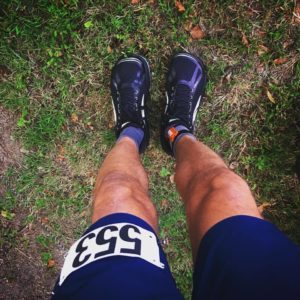 According to the numbers, I came in 7th among 46 runners in my race. However, there’s no number that can define what this race was for me.
According to the numbers, I came in 7th among 46 runners in my race. However, there’s no number that can define what this race was for me.
It pushed me to what felt like my physical and mental limits until I learned they were not real limits at all and I could push past them.
I hated it. I loved it. It was exhilarating. It was exhausting. It was lonely. It was family. It was depleting. It was nourishing. I wanted to quit. I couldn’t stop. It was serenity. It was agony. It was heaven. It was hell. I lost myself. I found myself. I started. I finished.
Tips For Your First 100-Mile Race
Here are a few pointers for those who are embarking upon a 100-mile ultramarathon:
#1 – Talk directly with someone who has recently run the 100-mile race you have signed up for. The official website descriptions by race directors are helpful, but you will gain more insight and useful knowledge by conversing with one or two folks who have previously run the course and participated in the event.
#2 – Sample the race sports drink before the event. I’ve recently run two ultramarathons and did not like their choice of sports drink at the aid station. Sample the sports drink before the race to determine if it works for you, or if you need to rely mostly on a preferred sports drink you bring to the race. The best sports drink is the one that tastes good to you – because it means you will actually drink it.
#3 – Run with someone. 100 miles is a long way to run by yourself. If there are one or two or more people you know and can run with and support/encourage one another during the race, it can make a huge difference – especially in those later miles.
#4 – Don’t try new stuff. Don’t wear any new running clothes you’ve never worn before. If you get a new pair of running shoes for your race, make sure you have ample time to break them in. If you’re going to purchase new clothes or socks, wear and wash them a few times before your event. This also applies to sports gels and any fuel you plan to use during the race, and all gear, equipment and technology. Basically, you don’t want any unnecessary surprises. Your 100-mile run is not the time to experiment with stuff you’ve never used before.
#5 – Be prepared for down moments. Over the course of 100 miles, a lot happens mentally, psychologically, emotionally, and physically. There will be ups and downs, doubts, inner battles, and perhaps moments when you regret ever signing up for the race. This is normal. It doesn’t mean anything; it’s just part of it. Sometimes you just battle through it one step at a time. The good news is that just as there are down and difficult moments, there are also up and triumphant ones – breakthrough, exhilarating, hopeful, and victorious moments. Running 100 miles involves all of the above.
I’m over 40 years old, but I don’t give up easily. It wasn’t too long ago that I was exploring the idea of doing my first triathlon. If I can do it, you can too! I'm proof that with a little determination and training, you can get a great deal of fulfillment participating in marathons, triathlons… even ultramarathons.
